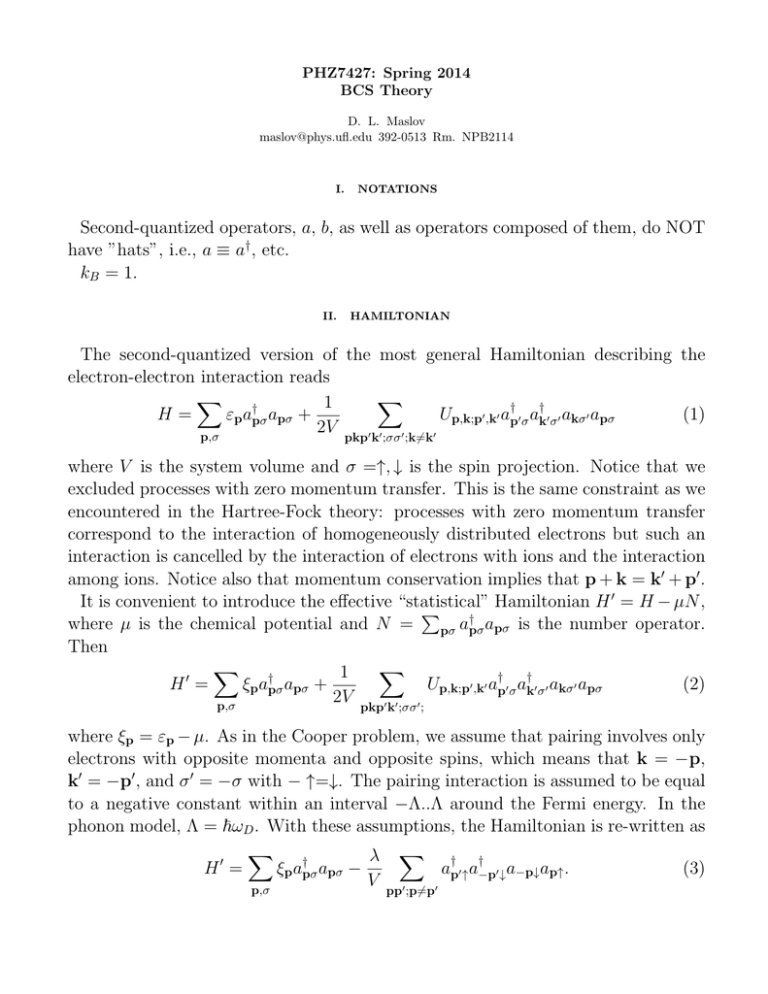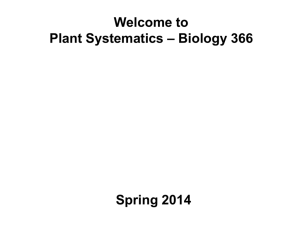Second-quantized operators, a, b, as well as operators composed of them,... have ”hats”, i.e., a ≡ a
advertisement

PHZ7427: Spring 2014 BCS Theory D. L. Maslov maslov@phys.ufl.edu 392-0513 Rm. NPB2114 I. NOTATIONS Second-quantized operators, a, b, as well as operators composed of them, do NOT have ”hats”, i.e., a ≡ a† , etc. kB = 1. II. HAMILTONIAN The second-quantized version of the most general Hamiltonian describing the electron-electron interaction reads X X 1 H= εp a†pσ apσ + Up,k;p0 ,k0 a†p0 σ a†k0 σ0 akσ0 apσ (1) 2V 0 0 0 0 p,σ pkp k ;σσ ;k6=k where V is the system volume and σ =↑, ↓ is the spin projection. Notice that we excluded processes with zero momentum transfer. This is the same constraint as we encountered in the Hartree-Fock theory: processes with zero momentum transfer correspond to the interaction of homogeneously distributed electrons but such an interaction is cancelled by the interaction of electrons with ions and the interaction among ions. Notice also that momentum conservation implies that p + k = k0 + p0 . It is convenient to introduce the effective “statistical” Hamiltonian H 0 = H − µN , P where µ is the chemical potential and N = pσ a†pσ apσ is the number operator. Then X X 1 H0 = ξp a†pσ apσ + Up,k;p0 ,k0 a†p0 σ a†k0 σ0 akσ0 apσ (2) 2V 0 0 0 p,σ pkp k ;σσ ; where ξp = εp − µ. As in the Cooper problem, we assume that pairing involves only electrons with opposite momenta and opposite spins, which means that k = −p, k0 = −p0 , and σ 0 = −σ with − ↑=↓. The pairing interaction is assumed to be equal to a negative constant within an interval −Λ..Λ around the Fermi energy. In the phonon model, Λ = ~ωD . With these assumptions, the Hamiltonian is re-written as X λ X † † 0 † H = ξp apσ apσ − ap0 ↑ a−p0 ↓ a−p↓ ap↑ . (3) V 0 0 p,σ pp ;p6=p 2 III. BOGOLIUBOV TRANSFORMATION The idea due to Bogoliuibov is to introduce new fermions which are linear superpositions of the p ↑ and −p ↓ states: bp↑ = up ap↑ − vp a†−p↓ bp↓ = up ap↓ + vp a†−p↑ (4) The coefficients up and vp (“coherence factors”) can depend only on the magnitude of p in an isotropic system. The admixture of the opposite momentum, opposite spin state (measured by vp ) is non-zero due to the pairing interaction. You will have to show in Homework # 4 that b and b† satisfy canonical commutation relations for fermions, bpσ b†pσ + b†pσ bpσ = 1, (5) provided that |up |2 + |vp |2 = 1. One can always choose these coefficients to be real, so that u2p + vp2 = 1. (6) Substituting Eq. (4) into Eq. (3) one obtains with the help of Eqs. (5) and (6) i X h † † † † 2 2 2 0 ξp 2vp + up − vp bp↑ bp↑ + bp↓ bp↓ + 2up vp bp↑ b−p↓ + b−p↓ bp↑ H = p λX † − Bp0 Bp V 0 (7) pp where Bp = u2p b−p↓ bp↑ − vp2 b†p↑ b†−p↓ + vp up b−p↓ b†−p↓ − b†p↑ bp↑ . (8) (Again, you will have to fill the gap in the derivation in Homework #4). Now, we require the total energy of the system to be at its minimum at fixed values of the occupation numbers npσ = hb†pσ bpσ i. (The last condition means that the entropy of the system, which is defined by the occupation numbers, is fixed; thus we minimize the energy at fixed entropy.) In equilibrium only the two combinations of b and b† has non-zero expectation values: hb†pσ bpσ i = npσ and hbpσ b†pσ i = 1 − npσ . In the absence of the magnetic field, np↑ = np↓ ≡ np , and also np = n−p in equilibrium. The expectation value of the first line in Eq. (7) for H 0 is the given by X hH 0 i1st line = 2ξp vp2 + u2p − vp2 np (9) p 3 To average the second line, we recall that due to the constraint p 6= p0 the factors Bp† 0 and Bp are to be averaged independently #2 " X X X λ hBp† 0 ihBp i = − up vp (1 − 2np ) . (10) hBp† 0 Bp i = V 0 0 0 0 p pp ;p6=p pp ;p6=p Notice that only the last term in Eq. (8) contributes to the result. Collecting the two contributions, we obtain for the total energy #2 " X X 2 λ 2ξp vp + u2p − vp2 np − E= up vp (1 − 2np ) . (11) V p p So far, the coefficients up and vp are arbitrary, except for the normalization condition δE (6). Now we choose up and vp in such a way that E is minimized, i.e., δu = 0 (it p does not matter if we vary up or vp ). Using the constraint (6) and relabeling p → p1 , re-write the first term in Eq. (11) as X X E1 = 2ξp1 vp21 + u2p1 − vp21 np1 = 2ξp1 1 − u2p1 + 2u2p1 − 1 np1 (12) p1 p1 hence δE1 = −4ξp up (1 − 2np ). δup The variation of the second term is " #2 X δE2 λ δ = − up1 vp1 (1 − 2np1 ) δup V δup p 1 X λ dvp vp + up (1 − 2np ) up0 vp0 (1 − 2np0 ). = −2 V dup 0 (13) (14) p From Eq. (6), we find dvp /dup = −up /vp so that X δE2 λ vp2 − u2p = −2 (1 − 2np ) up0 vp0 (1 − 2np0 ). δup V vp 0 (15) p Combining E1 and E2 together, we obtain the minimization condition X δE 2 λ = − (1 − 2np ) 2ξp up vp − (u2p − vp2 ) up0 vp0 (1 − 2np0 ) = 0. δup vp V 0 p (16) 4 or 2ξp up vp = ∆(u2p − vp2 ), (17) where ∆≡ λX up0 vp0 (1 − 2np0 ) V 0 (18) p Substituting vp = q 1 − u2p into Eq. (17) and squaring the whole equation, we obtain a quadratic equation for u2p u4p − u2p ∆2 + =0 4(∆2 + ξp2 ) (19) with the solutions u2p = 1 |ξp | 1 ± q . 2 2 2 ∆ + ξp (20) Hence vp2 = 1 − u2p = |ξp | 1 1 ∓ q . 2 ∆2 + ξp2 (21) We can choose any sign here: indeed, what matters for the calculation of ∆ is the product v v u u 1 ∆ |ξp | |ξp | 1u u = q (22) up vp = t1 ± q t1 ∓ q 2 2 2 2 2 2 2 2 ∆ + ξp ∆ + ξp ∆ + ξp for both cases. Substituting Eq. (22) into Eq. (17) and replacing the sum over p by an integral, we obtain a self-consistent equation for ∆ Z λ d3 p 1 − 2np q =1 (23) 2 (2π~)3 ∆2 + ξ 2 p which is reminiscent of the Cooper equation for the bound state energy. The energy ∆ plays the role of a gap in the energy spectrum. Notice that Fermi function in the equation above contains a yet unknown energy of excitations in this system 1 np = , (24) Ep exp T + 1 5 where Ep is yet to be found. However, if we define Ep as the excitation energy above the ground state, then Ep > 0 and thus np = 0 at T = 0. In this case, the equation for ∆(T = 0) ≡ ∆0 becomes Z d3 p 1 λ q =1 (25) 3 2 (2π~) 2 2 ∆0 + ξp Converting the integral over the p to that over ξp , assuming that the density of states is nearly independent of the energy, and cutting the energy integration at |ξ| = ~ωD , we obtain Z Z dξ λgF ~ωD λgF ~ωD λgF ~ωD dξ p = ln = 1 → ∆0 = ~ωD exp(−2/λgF ), ≈ 2 0 2 ∆0 ξ 2 ∆0 ∆20 + ξ 2 (26) where gF is the density of states at the Fermi energy. Note that this result is twice smaller than the Cooper’s result for the bound state energy.






